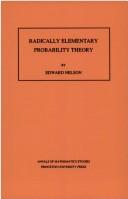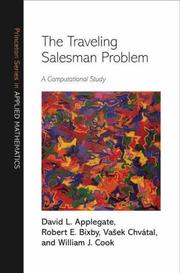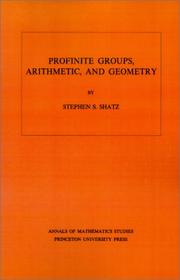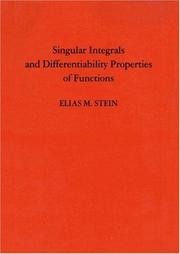| Listing 1 - 7 of 7 |
Sort by
|

ISBN: 0691084734 0691084742 1400882141 Year: 1987 Publisher: Princeton Princeton University Press
Abstract | Keywords | Export | Availability | Bookmark
 Loading...
Loading...Choose an application
- Reference Manager
- EndNote
- RefWorks (Direct export to RefWorks)
Using only the very elementary framework of finite probability spaces, this book treats a number of topics in the modern theory of stochastic processes. This is made possible by using a small amount of Abraham Robinson's nonstandard analysis and not attempting to convert the results into conventional form.
Martingales (Mathematics) --- Stochastic processes. --- Probabilities. --- Martingales (Mathematics). --- Stochastic processes --- Probability --- Statistical inference --- Combinations --- Mathematics --- Chance --- Least squares --- Mathematical statistics --- Risk --- Random processes --- Probabilities --- Abraham Robinson. --- Absolute value. --- Addition. --- Algebra of random variables. --- Almost surely. --- Axiom. --- Axiomatic system. --- Borel set. --- Bounded function. --- Cantor's diagonal argument. --- Cardinality. --- Cartesian product. --- Central limit theorem. --- Chebyshev's inequality. --- Compact space. --- Contradiction. --- Convergence of random variables. --- Corollary. --- Correlation coefficient. --- Counterexample. --- Dimension (vector space). --- Dimension. --- Division by zero. --- Elementary function. --- Estimation. --- Existential quantification. --- Family of sets. --- Finite set. --- Hyperplane. --- Idealization. --- Independence (probability theory). --- Indicator function. --- Infinitesimal. --- Internal set theory. --- Joint probability distribution. --- Law of large numbers. --- Linear function. --- Martingale (probability theory). --- Mathematical induction. --- Mathematician. --- Mathematics. --- Measure (mathematics). --- N0. --- Natural number. --- Non-standard analysis. --- Norm (mathematics). --- Orthogonal complement. --- Parameter. --- Path space. --- Predictable process. --- Probability distribution. --- Probability measure. --- Probability space. --- Probability theory. --- Probability. --- Product topology. --- Projection (linear algebra). --- Quadratic variation. --- Random variable. --- Real number. --- Requirement. --- Scientific notation. --- Sequence. --- Set (mathematics). --- Significant figures. --- Special case. --- Standard deviation. --- Statistical mechanics. --- Stochastic process. --- Subalgebra. --- Subset. --- Summation. --- Theorem. --- Theory. --- Total variation. --- Transfer principle. --- Transfinite number. --- Trigonometric functions. --- Upper and lower bounds. --- Variable (mathematics). --- Variance. --- Vector space. --- W0. --- Wiener process. --- Without loss of generality.
Book
ISBN: 0691145423 0691145415 9780691145419 9780691145426 1282645064 9786612645068 1400835402 9781400835409 Year: 2010 Publisher: Princeton, NJ
Abstract | Keywords | Export | Availability | Bookmark
 Loading...
Loading...Choose an application
- Reference Manager
- EndNote
- RefWorks (Direct export to RefWorks)
Ramsey theory is a fast-growing area of combinatorics with deep connections to other fields of mathematics such as topological dynamics, ergodic theory, mathematical logic, and algebra. The area of Ramsey theory dealing with Ramsey-type phenomena in higher dimensions is particularly useful. Introduction to Ramsey Spaces presents in a systematic way a method for building higher-dimensional Ramsey spaces from basic one-dimensional principles. It is the first book-length treatment of this area of Ramsey theory, and emphasizes applications for related and surrounding fields of mathematics, such as set theory, combinatorics, real and functional analysis, and topology. In order to facilitate accessibility, the book gives the method in its axiomatic form with examples that cover many important parts of Ramsey theory both finite and infinite. An exciting new direction for combinatorics, this book will interest graduate students and researchers working in mathematical subdisciplines requiring the mastery and practice of high-dimensional Ramsey theory.
Algebraic spaces. --- Ramsey theory. --- Ramsey theory --- Algebraic spaces --- Mathematics --- Algebra --- Physical Sciences & Mathematics --- Spaces, Algebraic --- Geometry, Algebraic --- Combinatorial analysis --- Graph theory --- Analytic set. --- Axiom of choice. --- Baire category theorem. --- Baire space. --- Banach space. --- Bijection. --- Binary relation. --- Boolean prime ideal theorem. --- Borel equivalence relation. --- Borel measure. --- Borel set. --- C0. --- Cantor cube. --- Cantor set. --- Cantor space. --- Cardinality. --- Characteristic function (probability theory). --- Characterization (mathematics). --- Combinatorics. --- Compact space. --- Compactification (mathematics). --- Complete metric space. --- Completely metrizable space. --- Constructible universe. --- Continuous function (set theory). --- Continuous function. --- Corollary. --- Countable set. --- Counterexample. --- Decision problem. --- Dense set. --- Diagonalization. --- Dimension (vector space). --- Dimension. --- Discrete space. --- Disjoint sets. --- Dual space. --- Embedding. --- Equation. --- Equivalence relation. --- Existential quantification. --- Family of sets. --- Forcing (mathematics). --- Forcing (recursion theory). --- Gap theorem. --- Geometry. --- Ideal (ring theory). --- Infinite product. --- Lebesgue measure. --- Limit point. --- Lipschitz continuity. --- Mathematical induction. --- Mathematical problem. --- Mathematics. --- Metric space. --- Metrization theorem. --- Monotonic function. --- Natural number. --- Natural topology. --- Neighbourhood (mathematics). --- Null set. --- Open set. --- Order type. --- Partial function. --- Partially ordered set. --- Peano axioms. --- Point at infinity. --- Pointwise. --- Polish space. --- Probability measure. --- Product measure. --- Product topology. --- Property of Baire. --- Ramsey's theorem. --- Right inverse. --- Scalar multiplication. --- Schauder basis. --- Semigroup. --- Sequence. --- Sequential space. --- Set (mathematics). --- Set theory. --- Sperner family. --- Subsequence. --- Subset. --- Subspace topology. --- Support function. --- Symmetric difference. --- Theorem. --- Topological dynamics. --- Topological group. --- Topological space. --- Topology. --- Tree (data structure). --- Unit interval. --- Unit sphere. --- Variable (mathematics). --- Well-order. --- Zorn's lemma.
Book
ISBN: 0691080275 069162612X 0691652449 140087453X Year: 1974 Publisher: Princeton (N.J.): Princeton university press
Abstract | Keywords | Export | Availability | Bookmark
 Loading...
Loading...Choose an application
- Reference Manager
- EndNote
- RefWorks (Direct export to RefWorks)
The theory of Riemann surfaces has a geometric and an analytic part. The former deals with the axiomatic definition of a Riemann surface, methods of construction, topological equivalence, and conformal mappings of one Riemann surface on another. The analytic part is concerned with the existence and properties of functions that have a special character connected with the conformal structure, for instance: subharmonic, harmonic, and analytic functions.Originally published in 1960.The Princeton Legacy Library uses the latest print-on-demand technology to again make available previously out-of-print books from the distinguished backlist of Princeton University Press. These editions preserve the original texts of these important books while presenting them in durable paperback and hardcover editions. The goal of the Princeton Legacy Library is to vastly increase access to the rich scholarly heritage found in the thousands of books published by Princeton University Press since its founding in 1905.
515.16 --- 515.16 Topology of manifolds --- Topology of manifolds --- Riemann surfaces. --- Topology. --- Analysis situs --- Position analysis --- Rubber-sheet geometry --- Geometry --- Polyhedra --- Set theory --- Algebras, Linear --- Surfaces, Riemann --- Functions --- Analytic function. --- Axiom of choice. --- Basis (linear algebra). --- Betti number. --- Big O notation. --- Bijection. --- Bilinear form. --- Bolzano–Weierstrass theorem. --- Boundary (topology). --- Boundary value problem. --- Bounded set (topological vector space). --- Branch point. --- Canonical basis. --- Cauchy sequence. --- Cauchy's integral formula. --- Characterization (mathematics). --- Coefficient. --- Commutator subgroup. --- Compact space. --- Compactification (mathematics). --- Conformal map. --- Connected space. --- Connectedness. --- Continuous function (set theory). --- Continuous function. --- Coset. --- Cross-cap. --- Dirichlet integral. --- Disjoint union. --- Elementary function. --- Elliptic surface. --- Exact differential. --- Existence theorem. --- Existential quantification. --- Extremal length. --- Family of sets. --- Finite intersection property. --- Finitely generated abelian group. --- Free group. --- Function (mathematics). --- Fundamental group. --- Green's function. --- Harmonic differential. --- Harmonic function. --- Harmonic measure. --- Heine–Borel theorem. --- Homeomorphism. --- Homology (mathematics). --- Ideal point. --- Infimum and supremum. --- Isolated point. --- Isolated singularity. --- Jordan curve theorem. --- Lebesgue integration. --- Limit point. --- Line segment. --- Linear independence. --- Linear map. --- Maximal set. --- Maximum principle. --- Meromorphic function. --- Metric space. --- Normal operator. --- Normal subgroup. --- Open set. --- Orientability. --- Orthogonal complement. --- Partition of unity. --- Point at infinity. --- Polyhedron. --- Positive harmonic function. --- Principal value. --- Projection (linear algebra). --- Projection (mathematics). --- Removable singularity. --- Riemann mapping theorem. --- Riemann surface. --- Semi-continuity. --- Sign (mathematics). --- Simplicial homology. --- Simply connected space. --- Singular homology. --- Skew-symmetric matrix. --- Special case. --- Subgroup. --- Subset. --- Summation. --- Support (mathematics). --- Taylor series. --- Theorem. --- Topological space. --- Triangle inequality. --- Uniform continuity. --- Uniformization theorem. --- Unit disk. --- Upper and lower bounds. --- Upper half-plane. --- Weyl's lemma (Laplace equation). --- Zorn's lemma.

ISBN: 1283256118 9786613256119 1400841100 9781400841103 0691129932 9780691129938 9781283256117 Year: 2011 Publisher: Princeton, NJ
Abstract | Keywords | Export | Availability | Bookmark
 Loading...
Loading...Choose an application
- Reference Manager
- EndNote
- RefWorks (Direct export to RefWorks)
This book presents the latest findings on one of the most intensely investigated subjects in computational mathematics--the traveling salesman problem. It sounds simple enough: given a set of cities and the cost of travel between each pair of them, the problem challenges you to find the cheapest route by which to visit all the cities and return home to where you began. Though seemingly modest, this exercise has inspired studies by mathematicians, chemists, and physicists. Teachers use it in the classroom. It has practical applications in genetics, telecommunications, and neuroscience. The authors of this book are the same pioneers who for nearly two decades have led the investigation into the traveling salesman problem. They have derived solutions to almost eighty-six thousand cities, yet a general solution to the problem has yet to be discovered. Here they describe the method and computer code they used to solve a broad range of large-scale problems, and along the way they demonstrate the interplay of applied mathematics with increasingly powerful computing platforms. They also give the fascinating history of the problem--how it developed, and why it continues to intrigue us.
Traveling salesman problem. --- TSP (Traveling salesman problem) --- Combinatorial optimization --- Graph theory --- Vehicle routing problem --- AT&T Labs. --- Accuracy and precision. --- Addition. --- Algorithm. --- Analysis of algorithms. --- Applied mathematics. --- Approximation algorithm. --- Approximation. --- Basic solution (linear programming). --- Best, worst and average case. --- Bifurcation theory. --- Big O notation. --- CPLEX. --- CPU time. --- Calculation. --- Chaos theory. --- Column generation. --- Combinatorial optimization. --- Computation. --- Computational resource. --- Computer. --- Connected component (graph theory). --- Connectivity (graph theory). --- Convex hull. --- Cutting-plane method. --- Delaunay triangulation. --- Determinism. --- Disjoint sets. --- Dynamic programming. --- Ear decomposition. --- Engineering. --- Enumeration. --- Equation. --- Estimation. --- Euclidean distance. --- Euclidean space. --- Family of sets. --- For loop. --- Genetic algorithm. --- George Dantzig. --- Georgia Institute of Technology. --- Greedy algorithm. --- Hamiltonian path. --- Hospitality. --- Hypergraph. --- Implementation. --- Instance (computer science). --- Institute. --- Integer. --- Iteration. --- Linear inequality. --- Linear programming. --- Mathematical optimization. --- Mathematics. --- Model of computation. --- Neuroscience. --- Notation. --- Operations research. --- Optimization problem. --- Order by. --- Pairwise. --- Parameter (computer programming). --- Parity (mathematics). --- Percentage. --- Polyhedron. --- Polytope. --- Pricing. --- Princeton University. --- Processing (programming language). --- Project. --- Quantity. --- Reduced cost. --- Requirement. --- Result. --- Rice University. --- Rutgers University. --- Scientific notation. --- Search algorithm. --- Search tree. --- Self-similarity. --- Simplex algorithm. --- Solution set. --- Solver. --- Source code. --- Special case. --- Stochastic. --- Subroutine. --- Subsequence. --- Subset. --- Summation. --- Test set. --- Theorem. --- Theory. --- Time complexity. --- Trade-off. --- Travelling salesman problem. --- Tree (data structure). --- Upper and lower bounds. --- Variable (computer science). --- Variable (mathematics).

ISBN: 0691080178 1400881854 9780691080178 Year: 1972 Volume: 67 Publisher: Princeton (N.J.): Princeton university press
Abstract | Keywords | Export | Availability | Bookmark
 Loading...
Loading...Choose an application
- Reference Manager
- EndNote
- RefWorks (Direct export to RefWorks)
In this volume, the author covers profinite groups and their cohomology, Galois cohomology, and local class field theory, and concludes with a treatment of duality. His objective is to present effectively that body of material upon which all modern research in Diophantine geometry and higher arithmetic is based, and to do so in a manner that emphasizes the many interesting lines of inquiry leading from these foundations.
Group theory --- Finite groups --- Algebraic number theory --- 512.73 --- 512.66 --- Homology theory --- Number theory --- Cohomology theory --- Contrahomology theory --- Algebraic topology --- Groups, Finite --- Modules (Algebra) --- Cohomology theory of algebraic varieties and schemes --- Homological algebra --- 512.66 Homological algebra --- 512.73 Cohomology theory of algebraic varieties and schemes --- Groupes, Théorie des. --- Group theory. --- Homology theory. --- Finite groups. --- Algebraic number theory. --- Abelian group. --- Alexander Grothendieck. --- Algebraic closure. --- Algebraic extension. --- Algebraic geometry. --- Algebraic number field. --- Brauer group. --- Category of abelian groups. --- Category of sets. --- Characterization (mathematics). --- Class field theory. --- Cohomological dimension. --- Cohomology. --- Cokernel. --- Commutative diagram. --- Composition series. --- Computation. --- Connected component (graph theory). --- Coset. --- Cup product. --- Dedekind domain. --- Degeneracy (mathematics). --- Diagram (category theory). --- Dimension (vector space). --- Diophantine geometry. --- Discrete group. --- Equivalence of categories. --- Exact sequence. --- Existential quantification. --- Explicit formula. --- Exponential function. --- Family of sets. --- Field extension. --- Finite group. --- Fundamental class. --- G-module. --- Galois cohomology. --- Galois extension. --- Galois group. --- Galois module. --- Galois theory. --- General topology. --- Geometry. --- Grothendieck topology. --- Group cohomology. --- Group extension. --- Group scheme. --- Hilbert symbol. --- Hopf algebra. --- Ideal (ring theory). --- Inequality (mathematics). --- Injective sheaf. --- Inner automorphism. --- Inverse limit. --- Kummer theory. --- Lie algebra. --- Linear independence. --- Local field. --- Mathematical induction. --- Mathematician. --- Mathematics. --- Module (mathematics). --- Morphism. --- Natural topology. --- Neighbourhood (mathematics). --- Normal extension. --- Normal subgroup. --- Number theory. --- P-adic number. --- P-group. --- Polynomial. --- Pontryagin duality. --- Power series. --- Prime number. --- Principal ideal. --- Profinite group. --- Quadratic reciprocity. --- Quotient group. --- Ring of integers. --- Sheaf (mathematics). --- Special case. --- Subcategory. --- Subgroup. --- Supernatural number. --- Sylow theorems. --- Tangent space. --- Theorem. --- Topological group. --- Topological property. --- Topological ring. --- Topological space. --- Topology. --- Torsion group. --- Torsion subgroup. --- Transcendence degree. --- Triviality (mathematics). --- Unique factorization domain. --- Variable (mathematics). --- Vector space. --- Groupes, Théorie des --- Nombres, Théorie des
Book
ISBN: 0691141843 0691141851 9786612303807 1282303805 1400831067 9781400831067 9781282303805 9780691141848 9780691141855 Year: 2009 Volume: 172 Publisher: Princeton, NJ
Abstract | Keywords | Export | Availability | Bookmark
 Loading...
Loading...Choose an application
- Reference Manager
- EndNote
- RefWorks (Direct export to RefWorks)
The results established in this book constitute a new departure in ergodic theory and a significant expansion of its scope. Traditional ergodic theorems focused on amenable groups, and relied on the existence of an asymptotically invariant sequence in the group, the resulting maximal inequalities based on covering arguments, and the transference principle. Here, Alexander Gorodnik and Amos Nevo develop a systematic general approach to the proof of ergodic theorems for a large class of non-amenable locally compact groups and their lattice subgroups. Simple general conditions on the spectral theory of the group and the regularity of the averaging sets are formulated, which suffice to guarantee convergence to the ergodic mean. In particular, this approach gives a complete solution to the problem of establishing mean and pointwise ergodic theorems for the natural averages on semisimple algebraic groups and on their discrete lattice subgroups. Furthermore, an explicit quantitative rate of convergence to the ergodic mean is established in many cases. The topic of this volume lies at the intersection of several mathematical fields of fundamental importance. These include ergodic theory and dynamics of non-amenable groups, harmonic analysis on semisimple algebraic groups and their homogeneous spaces, quantitative non-Euclidean lattice point counting problems and their application to number theory, as well as equidistribution and non-commutative Diophantine approximation. Many examples and applications are provided in the text, demonstrating the usefulness of the results established.
Dynamics. --- Ergodic theory. --- Harmonic analysis. --- Lattice theory. --- Lie groups. --- Ergodic theory --- Lie groups --- Lattice theory --- Harmonic analysis --- Dynamics --- Calculus --- Mathematics --- Physical Sciences & Mathematics --- Dynamical systems --- Kinetics --- Analysis (Mathematics) --- Functions, Potential --- Potential functions --- Lattices (Mathematics) --- Space lattice (Mathematics) --- Structural analysis (Mathematics) --- Groups, Lie --- Ergodic transformations --- Mechanics, Analytic --- Force and energy --- Mechanics --- Physics --- Statics --- Banach algebras --- Mathematical analysis --- Bessel functions --- Fourier series --- Harmonic functions --- Time-series analysis --- Algebra, Abstract --- Algebra, Boolean --- Group theory --- Set theory --- Topology --- Transformations (Mathematics) --- Crystallography, Mathematical --- Lie algebras --- Symmetric spaces --- Topological groups --- Continuous groups --- Mathematical physics --- Measure theory --- Absolute continuity. --- Algebraic group. --- Amenable group. --- Asymptote. --- Asymptotic analysis. --- Asymptotic expansion. --- Automorphism. --- Borel set. --- Bounded function. --- Bounded operator. --- Bounded set (topological vector space). --- Congruence subgroup. --- Continuous function. --- Convergence of random variables. --- Convolution. --- Coset. --- Counting problem (complexity). --- Counting. --- Differentiable function. --- Dimension (vector space). --- Diophantine approximation. --- Direct integral. --- Direct product. --- Discrete group. --- Embedding. --- Equidistribution theorem. --- Ergodicity. --- Estimation. --- Explicit formulae (L-function). --- Family of sets. --- Haar measure. --- Hilbert space. --- Hyperbolic space. --- Induced representation. --- Infimum and supremum. --- Initial condition. --- Interpolation theorem. --- Invariance principle (linguistics). --- Invariant measure. --- Irreducible representation. --- Isometry group. --- Iwasawa group. --- Lattice (group). --- Lie algebra. --- Linear algebraic group. --- Linear space (geometry). --- Lipschitz continuity. --- Mass distribution. --- Mathematical induction. --- Maximal compact subgroup. --- Maximal ergodic theorem. --- Measure (mathematics). --- Mellin transform. --- Metric space. --- Monotonic function. --- Neighbourhood (mathematics). --- Normal subgroup. --- Number theory. --- One-parameter group. --- Operator norm. --- Orthogonal complement. --- P-adic number. --- Parametrization. --- Parity (mathematics). --- Pointwise convergence. --- Pointwise. --- Principal homogeneous space. --- Principal series representation. --- Probability measure. --- Probability space. --- Probability. --- Rate of convergence. --- Regular representation. --- Representation theory. --- Resolution of singularities. --- Sobolev space. --- Special case. --- Spectral gap. --- Spectral method. --- Spectral theory. --- Square (algebra). --- Subgroup. --- Subsequence. --- Subset. --- Symmetric space. --- Tensor algebra. --- Tensor product. --- Theorem. --- Transfer principle. --- Unit sphere. --- Unit vector. --- Unitary group. --- Unitary representation. --- Upper and lower bounds. --- Variable (mathematics). --- Vector group. --- Vector space. --- Volume form. --- Word metric.

ISBN: 0691080798 1400883881 9780691080796 Year: 1970 Volume: 30 Publisher: Princeton (N.J.) Princeton university press
Abstract | Keywords | Export | Availability | Bookmark
 Loading...
Loading...Choose an application
- Reference Manager
- EndNote
- RefWorks (Direct export to RefWorks)
Singular integrals are among the most interesting and important objects of study in analysis, one of the three main branches of mathematics. They deal with real and complex numbers and their functions. In this book, Princeton professor Elias Stein, a leading mathematical innovator as well as a gifted expositor, produced what has been called the most influential mathematics text in the last thirty-five years. One reason for its success as a text is its almost legendary presentation: Stein takes arcane material, previously understood only by specialists, and makes it accessible even to beginning graduate students. Readers have reflected that when you read this book, not only do you see that the greats of the past have done exciting work, but you also feel inspired that you can master the subject and contribute to it yourself. Singular integrals were known to only a few specialists when Stein's book was first published. Over time, however, the book has inspired a whole generation of researchers to apply its methods to a broad range of problems in many disciplines, including engineering, biology, and finance. Stein has received numerous awards for his research, including the Wolf Prize of Israel, the Steele Prize, and the National Medal of Science. He has published eight books with Princeton, including Real Analysis in 2005.
Functions of real variables. --- Harmonic analysis. --- Singular integrals. --- Multiplicateurs (analyse mathématique) --- Multipliers (Mathematical analysis) --- Functional analysis --- Harmonic analysis. Fourier analysis --- Functions of real variables --- Harmonic analysis --- Singular integrals --- Fonctions de variables réelles --- Analyse harmonique --- Intégrales singulières --- Fonctions de plusieurs variables réelles --- Calcul différentiel --- Functions of several real variables --- Differential calculus --- 517.518.5 --- Integrals, Singular --- Integral operators --- Integral transforms --- Analysis (Mathematics) --- Functions, Potential --- Potential functions --- Banach algebras --- Calculus --- Mathematical analysis --- Mathematics --- Bessel functions --- Fourier series --- Harmonic functions --- Time-series analysis --- Real variables --- Functions of complex variables --- 517.518.5 Theory of the Fourier integral --- Theory of the Fourier integral --- A priori estimate. --- Analytic function. --- Banach algebra. --- Banach space. --- Basis (linear algebra). --- Bessel function. --- Bessel potential. --- Big O notation. --- Borel measure. --- Boundary value problem. --- Bounded function. --- Bounded operator. --- Bounded set (topological vector space). --- Bounded variation. --- Boundedness. --- Cartesian product. --- Change of variables. --- Characteristic function (probability theory). --- Characterization (mathematics). --- Commutative property. --- Complex analysis. --- Complex number. --- Continuous function (set theory). --- Continuous function. --- Convolution. --- Derivative. --- Difference "ient. --- Difference set. --- Differentiable function. --- Dimension (vector space). --- Dimensional analysis. --- Dirac measure. --- Dirichlet problem. --- Distribution function. --- Division by zero. --- Dot product. --- Dual space. --- Equation. --- Existential quantification. --- Family of sets. --- Fatou's theorem. --- Finite difference. --- Fourier analysis. --- Fourier series. --- Fourier transform. --- Function space. --- Green's theorem. --- Harmonic function. --- Hilbert space. --- Hilbert transform. --- Homogeneous function. --- Infimum and supremum. --- Integral transform. --- Interpolation theorem. --- Interval (mathematics). --- Linear map. --- Lipschitz continuity. --- Lipschitz domain. --- Locally integrable function. --- Marcinkiewicz interpolation theorem. --- Mathematical induction. --- Maximal function. --- Maximum principle. --- Mean value theorem. --- Measure (mathematics). --- Modulus of continuity. --- Multiple integral. --- Open set. --- Order of integration. --- Orthogonality. --- Orthonormal basis. --- Partial derivative. --- Partial differential equation. --- Partition of unity. --- Periodic function. --- Plancherel theorem. --- Pointwise. --- Poisson kernel. --- Polynomial. --- Real variable. --- Rectangle. --- Riesz potential. --- Riesz transform. --- Scientific notation. --- Sign (mathematics). --- Singular integral. --- Sobolev space. --- Special case. --- Splitting lemma. --- Subsequence. --- Subset. --- Summation. --- Support (mathematics). --- Theorem. --- Theory. --- Total order. --- Unit vector. --- Variable (mathematics). --- Zero of a function. --- Fonctions de plusieurs variables réelles --- Calcul différentiel --- Multiplicateurs (analyse mathématique)
| Listing 1 - 7 of 7 |
Sort by
|

 Search
Search Feedback
Feedback About UniCat
About UniCat  Help
Help News
News